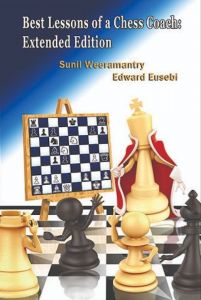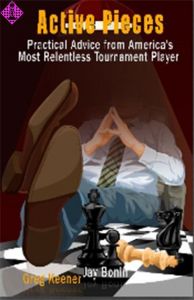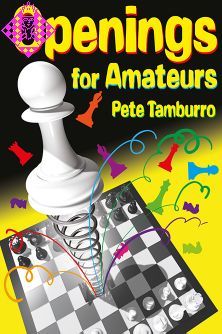Don’t have the time to study opening theory, or to figure out where you’re going wrong with your games? Are you looking for guidance on how to handle the opening so that you can get a playable middlegame?
Openings for Amateurs is written with two kinds of chessplayers in mind: average “club” players who can’t afford to learn variations 30 moves deep; and scholastic players looking to take the next step in their chess development.
This is really two books in one! The Primer covers the most frequent mistakes made in the opening and considers many common misconceptions about this phase of the game. Popular chess author and lecturer Pete Tamburro devotes special attention to the best ways to meet both tricky lines like the Blackmar-Diemer and the Belgrade Gambit, and “system” attacks such as the Colle and the Barry, while discussing such vexing topics as when to chase a bishop and whether to believe openings manuals.
Part II offers a selection of openings that you are invited to consider based on your needs, and presents 53 annotated model games to help you understand the openings’ ideas rather than just memorizing moves. The aim is to help you determine where you are now and then how to pursue your chess goals - while helping you right away to survive the opening in your next tournament!
About the Author
Chess Life and Chess Life for Kids columnist Pete Tamburro hosted the popular Openings for Amateurs lecture series on chess.fm and the Internet Chess Club. In addition to coaching college basketball and championship high-school chess and cross-country teams, Pete has been voted Chess Journalist of the Year (2006) and named New Jersey’s Outstanding Teacher of History (1990). His chess books include writing Learn Chess from the Greats and editing the Kasparov Foundation’s Teaching Chess Step by Step series.
| Gewicht | 440 g |
|---|---|
| Hersteller | Mongoose |
| Breite | 15,4 cm |
| Höhe | 23 cm |
| Medium | Buch |
| Erscheinungsjahr | 2014 |
| Autor | Pete Tamburro |
| Sprache | Englisch |
| Auflage | 1 |
| ISBN-13 | 978-1936277506 |
| Seiten | 336 |
| Einband | kartoniert |
011 Introduction
015 PART I: THE PRIMER
018 1. Allowing the king to give up castling without a good reason
019 2. Allowing early simplification
021 3. Don’t lose time in the opening
026 4. Don’t be an opening robot!
028 5. Don’t help your opponent to do what he wants to do!
029 6. Not all aggressive bishop moves are good
031 7. Don’t panic against unusual moves
034 8. Don’t create weaknesses that your opponent can exploit
035 9. Don’t forget that play in the center is the essential point of all openings
037 10. Be careful to avoid “plodding” development
038 11. Playing an opening (especially a defense) without understanding why certain moves are played and when they are played, is not a good idea
041 12. Know when it’s good to exchange a bishop for a knight and when it is not good. Oh – and vice versa!
045 13. Don’t turn a won game into a draw – or worse!
047 14. Always consider counterattacking in the center
048 15. If your opponent gives you the center, it’s generally a good idea to accept the gift!
050 16. Solid, passive defenses are the waiting rooms for defeat
050 17. Even though you have an opening plan, be alert to good moves in changing circumstances
051 18. Don’t forget, before every move, to look for all checks and captures
053 19. Know when to play g4 or ... g5 against a bishop and know when not to play it
063 20. Don’t make it easy for your opponent to make a freeing move
065 21. Don’t incorrectly use computers
066 22. Don’t be in a hurry to resign
067 23. Don’t sleep in the streets!
069 24. Be ever vigilant for Bxf7+
069 25. Do not be so eager to play so “solidly” that you block in your bishops
071 26. Don’t underestimate exchange variations
072 27. Beware sudden pawn thrusts!
073 28. Gambits are best met by countergambits. The best way to meet a gambit is to accept it. Huh?
095 29. Do not play premature attacks
099 30. Tempi! Tempi! Tempi!
100 31. Don’t go crazy against hedgehog or hippo-type openings
105 32. If you like attacking chess, don’t hesitate to use attacks based on h2-h4-h5 against fianchetto defenses
116 33. Don’t go crazy when facing an offbeat opening, either
123 34. When playing against the Colle System, do not think that simple, planless, developing moves will be sufficient
128 35. When facing some of the “pre-planned” openings, don’t be afraid to have your own plan ready to go
136 36. Speaking of preparation, don’t believe everything you read in opening books or articles (especially if you wrote them!)
141 37. Don’t just concentrate on openings!
143 38. Pete, what should I play in the openings? What do you do?
145 39. Once I’ve picked my openings, how should I study them?
145 40. What if I just want to have fun?
148 PART II: OPENINGS FOR AMATEURS
149 1. Sicilian (for White)
149 Hungarian Variation
163 Rossolimo Attack
167 Closed Sicilian
172 c3 Sicilian
177 2. French Defense
177 Tarrasch Variation with ... Nf6
180 Tarrasch Variation with ... c7-c5
183 Guimard Variation
188 3. Caro-Kann Defense
188 Horowitz suggestion
189 Keres suggestion
190 Fantasy Variation
197 4. Systems with ... g7-g6
197 Pirc
203 Modern
204 Gurgenidze
206 5. Alekhine’s Defense, Canal Variation
211 6. Scandinavian/Center Counter
211 3 ... Qa5 line
213 3 ... Qd6 line
215 2 ... Nf6 line
220 7. Four Knights’ Game
221 Classical Attack
229 Rubinstein Variation
231 8. Vienna Opening with g3
231 Black plays ... d7-d5
234 Black plays ... d7-d6
238 9. Two Knights’ Defense
239 Fritz Variation
243 Classical Variation
246 d4 Attack
249 10. Scotch Opening
254 11. If You Don’t Want to Play 1 ... e5 to Meet 1.e4: The Sicilian Dragon
268 12. The English Opening According to Botvinnik
283 13. Nimzo-Indian and Bogo-Indian
297 14. Dutch Defense
309 15. A Plea for the Ruy Ló pez
331 16. Final Thoughts
“There’s a need for a book such as this in today’s work-a-day world: Give it to me neat, no fizz. Cut to the chase. You won’t find reams of analysis, and no data dumps of variations. “You will find good, common-sense advice in the primer section (do’s and don’ts, good and evil), easily digested in nugget-sized morsels, followed by excellent model games. You can dine at your leisure, a chapter at a sitting, and walk away satisfied.” -Glenn Petersen (amateur in search of an opening), Editor, Chess Life for Kids
“Peter Tamburro’s excellent new text, Openings for Amateurs, is everything the recreational player needs to appreciate the opening phase of chess. But the author’s insights don’t stop in the first dozen moves. Glide through it and you can watch your entire game take on greater power and verve. On my list of recommended new chess books, it rises to the top.” -Bruce Pandolfini, renowned chess teacher and author
“When I read it, I felt like I was reading through an old-fashioned primer - easy to digest, even without a chessboard, and plenty of insight. This is my opinion - from the guy who always disliked openings and survived at the highest level by grinding out middlegames and endgames.”-IM Igor Khmelnitsky, award-winning author of Chess Exam and Training Guide
“Thank you Pete. You understand us amateurs better than almost anyone else. Speaking for the rest of us, I appreciate your help, advice, and time.” -A reader of Pete Tamburro’s “Openings for Amateurs” message board
-
 Chess Camp Vol. 19,95 €
Chess Camp Vol. 19,95 € -
 Amateur to IM / reduziert20,95 €
Amateur to IM / reduziert20,95 € -
 Amateur to IM25,95 €
Amateur to IM25,95 € -
 Best Lessons of a Chess Coach25,95 €
Best Lessons of a Chess Coach25,95 € -
 Baron Munchausen18,95 €
Baron Munchausen18,95 € -
 Active Pieces19,95 €
Active Pieces19,95 € -
 Best Play (hc)27,95 €
Best Play (hc)27,95 € - Mehr von Mongoose

